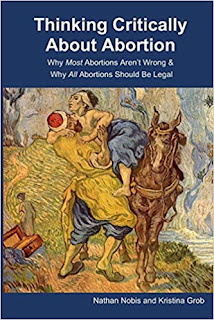Why Abortions Are Still Wrong and Should be Illegal (Part One)
 Nathan Nobis and Kristina Grob recently published a book called Thinking Critically About Abortion: Why Most Abortions Aren’t Wrong & Why All Abortions Should Be Legal. The book was designed to teach people on both sides of the aisle, pro-life and pro-choice, how to have better conversations on the topic by pointing out bad arguments, showing why they are bad, and then showing better arguments that should be focused on. The authors then expounded what they believe to be better arguments against abortion and argued against them, then used arguments for abortion and used them to show why they believe most abortions are not wrong and why all of them should be legal. In this article series, I intend to show 1) that the authors’ arguments fail to show why most abortions aren’t wrong and they all should be legal, 2) they fail to interact with some of the best arguments against abortion, and 3) even in the arguments they do give, they present strawman versions of some of the pro-life arguments they examine, and even then they don’t succeed in refuting any of the arguments. Nobis and Grob’s book has been made available to read for free on-line here.
Nathan Nobis and Kristina Grob recently published a book called Thinking Critically About Abortion: Why Most Abortions Aren’t Wrong & Why All Abortions Should Be Legal. The book was designed to teach people on both sides of the aisle, pro-life and pro-choice, how to have better conversations on the topic by pointing out bad arguments, showing why they are bad, and then showing better arguments that should be focused on. The authors then expounded what they believe to be better arguments against abortion and argued against them, then used arguments for abortion and used them to show why they believe most abortions are not wrong and why all of them should be legal. In this article series, I intend to show 1) that the authors’ arguments fail to show why most abortions aren’t wrong and they all should be legal, 2) they fail to interact with some of the best arguments against abortion, and 3) even in the arguments they do give, they present strawman versions of some of the pro-life arguments they examine, and even then they don’t succeed in refuting any of the arguments. Nobis and Grob’s book has been made available to read for free on-line here.
-
An abortion is the murder of an unborn baby or child.
-
An abortion is the intentional termination of a fetus to end a pregnancy.
-
An abortion is the intentional killing of a fetus to end a pregnancy.
This is why I tend to define abortion as “premature termination of a pregnancy with the result of the fetus’ death.” I think this is a more accurate and informative definition than even NG give, since it covers all the bases. I also think this is what most people tend to have in mind when they actually talk about abortions, even if they’re not quite sure how to articulate it. And this way, if we have a distinction between spontaneous abortion (miscarriage), therapeutic abortion (to save the mother’s life), and elective abortion (a procedure that is not medically indicated to save her life), only elective abortions would be morally problematic. A woman obviously should not be held responsible for a miscarriage beyond her control, nor should a woman be held responsible for a life-saving abortion if her life is in immediate jeopardy. But if her life is not immediately threatened, then having an abortion for any other reason makes her culpable for the act, even if not as culpable as the abortion practitioner who performs the abortion.
In the next part of this series, I’ll respond to NG’s chapter on fetal consciousness and facts of fetal development, and their chapter on bad arguments, if it doesn’t make the article too lengthy.

Leave a Reply
Want to join the discussion?Feel free to contribute!